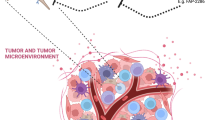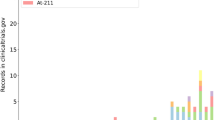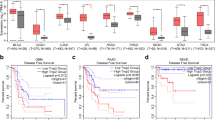Abstract
Radiopharmaceutical therapy using α-particle emitting radionuclides (αRPT) is a novel treatment modality that delivers highly potent alpha-particles to cancer cells or their environment. We review the advantages and challenges of imaging and dosimetry in implementing αRPT for cancer patients.
Similar content being viewed by others
Notes
Administered activity (AA) (a measured quantity) is the amount of radioactivity administered.
Absorbed dose is the “radiation energy” delivered to tissues (generally, a calculated quantity). The latter better predicts biological effects.
References
Sgouros G, et al. Radiopharmaceutical therapy in cancer: clinical advances and challenges. Nat Rev Drug Discov. 2020;19(9):589–608.
Sgouros G. Dosimetry, radiobiology and synthetic lethality: radiopharmaceutical therapy (RPT) with alpha-particle-emitters. Semin Nucl Med. 2020;50(2):124–32.
Sgouros G. α-Particle-Emitter Radiopharmaceutical Therapy: Resistance Is Futile. Cancer Res. 2019;79(21):5479–81.
Violet J, et al. Dosimetry of Lu-177-PSMA-617 in metastatic castration-resistant prostate cancer: correlations between pretherapeutic imaging and whole-body tumor dosimetry with treatment outcomes. J Nucl Med. 2019;60(4):517–23.
Dewaraja YK, et al. Tumor-absorbed dose predicts progression-free survival following (131)I-Tositumomab radioimmunotherapy. J Nucl Med. 2014;55(7):1047–53.
Cremonesi M, et al. Correlation of dose with toxicity and tumour response to Y-90- and Lu-177-PRRT provides the basis for optimization through individualized treatment planning. Eur J Nucl Med Mol Imaging. 2018;45(13):2426–41.
Sandstrom M, et al. Individualized Dosimetry of Kidney and Bone Marrow in Patients Undergoing Lu-177-DOTA-Octreotate Treatment. J Nucl Med. 2013;54(1):33–41.
Stokke C, et al. Dosimetry-based treatment planning for molecular radiotherapy: a summary of the 2017 report from the Internal Dosimetry Task Force. Ejnmmi Physics. 2017;4(1):27.
Sundlov A, et al. Individualised Lu-177-DOTATATE treatment of neuroendocrine tumours based on kidney dosimetry. Eur J Nucl Med Mol Imaging. 2017;44(9):1480–9.
Vilgrain V, et al. Efficacy and safety of selective internal radiotherapy with yttrium-90 resin microspheres compared with sorafenib in locally advanced and inoperable hepatocellular carcinoma (SARAH): an open-label randomised controlled phase 3 trial. Lancet Oncol. 2017;18(12):1624–36.
Bastiaannet R, et al. First evidence for a dose-response relationship in patients treated with Ho-166 radioembolization: a prospective study. J Nucl Med. 2020;61(4):608–12.
Garin E, et al. Personalised versus standard dosimetry approach of selective internal radiation therapy in patients with locally advanced hepatocellular carcinoma (DOSISPHERE-01): a randomised, multicentre, open-label phase 2 trial. Lancet Gastroenterol Hepatol. 2021;6(1):17–29.
Dagogo-Jack I, Shaw AT. Tumour heterogeneity and resistance to cancer therapies. Nat Rev Clin Oncol. 2018;15(2):81–94.
Prasad V, Fojo T, Brada M. Precision oncology: origins, optimism, and potential. Lancet Oncol. 2016;17(2):E81–6.
Hertz S, Roberts A. RADIOACTIVE IODINE IN THE STUDY OF THYROID PHYSIOLOGY .7. THE USE OF RADIOACTIVE IODINE THERAPY IN HYPERTHYROIDISM. Jama-J Am Med Assoc. 1946;131(2):81–6.
Hertz S, et al. Radioactive iodine as an indicator in thyroid physiology - iodine collection by normal and hyperplastic thyroids in rabbits. Am J Physiol. 1940;128(3):0565–76.
Hertz S, Roberts A, Evans RD. Radioactive iodine as an indicator in the study of thyroid physiology. Proc Soc Exp Biol Med. 1938;38(4):510–3.
Hertz B. A tribute to Dr. Saul Hertz: The discovery of the medical uses of radioiodine. World J Nucl Med. 2019;18(1):8–12.
Boatman JB, Moses C. RADIOIODINE CONCENTRATIONS AND CLEARANCES IN RATS RECEIVING IODINE. Thyroid Propylthiouracil Endocrinol. 1951;48(4):413–22.
Belshaw BE, et al. A model of iodine kinetics in the dog. Endocrinology. 1974;95(4):1078–93.
Benua R, et al. The relation of radioiodine dosimetry to results and complications in the treatment of metastatic thyroid cancer. Am J Roentgenol Radium Ther Nucl Med. 1962;87:171–82.
Sgouros G, et al. Lung toxicity in radioiodine therapy of thyroid carcinoma: development of a dose-rate method and dosimetric implications of the 80mCi rule. J Nucl Med. 2006;47(12):1977–84.
Hobbs RF, et al. 124I PET-based 3D-RD dosimetry for a pediatric thyroid cancer patient: real-time treatment planning and methodologic comparison. J Nucl Med. 2009;50(11):1844–7.
Ain KB. Management of undifferentiated thyroid cancer. Best Pract Res Clin Endocrinol Metab. 2000;14(4):615–29.
Ros P, et al. Thyroid-specific gene expression in the multi-step process of thyroid carcinogenesis. Biochimie. 1999;81(4):389–96.
Ho AL, et al. Selumetinib-enhanced radioiodine uptake in advanced thyroid cancer. N Engl J Med. 2013;368(7):623–32.
Hobbs RF, et al. A treatment planning method for sequentially combining radiopharmaceutical therapy and external radiation therapy. Int J Radiat Oncol Biol Phys. 2011;80(4):1256–62.
Kaminski MS, et al. Radioimmunotherapy of B-cell lymphoma with [131I]anti-B1 (anti-CD20) antibody. N Engl J Med. 1993;329(7):459–65.
Sgouros G, et al. Pharmacokinetics and dosimetry of an alpha-particle emitter labeled antibody: 213Bi-HuM195 (anti-CD33) in patients with leukemia. J Nucl Med. 1999;40(11):1935–46.
Kolbert KS, et al. Parametric images of antibody pharmacokinetics in Bi213-HuM195 therapy of leukemia. J Nucl Med. 2001;42(1):27–32.
Rosenblat TL, et al. Sequential cytarabine and alpha-particle immunotherapy with bismuth-213-lintuzumab (HuM195) for acute myeloid leukemia. Clin Cancer Res. 2010;16(21):5303–11.
Carrasquillo J, et al. Phase I pharmacokinetic and biodistribution study with escalating doses of 223Ra-dichloride in men with castration-resistant metastatic prostate cancer. Eur J Nucl Med Mol Imaging. 2013;40(9):1384–93.
Hindorf C, et al. Quantitative imaging of 223Ra-chloride (Alpharadin) for targeted alpha-emitting radionuclide therapy of bone metastases. Nucl Med Commun. 2012;33(7):726–32.
Chittenden SJ, et al. A phase 1, open-label study of the biodistribution, pharmacokinetics, and dosimetry of Ra-223-dichloride in patients with hormone-refractory prostate cancer and skeletal metastases. J Nucl Med. 2015;56(9):1304–9.
Taprogge J, et al. Compartmental model for Ra-223-dichloride in patients with metastatic bone disease from castration-resistant prostate cancer. Int J Radiat Oncol Biol Phys. 2019;105(4):884–92.
Yoshida K, et al. Pharmacokinetics of single dose radium-223 dichloride (BAY 88–8223) in Japanese patients with castration-resistant prostate cancer and bone metastases. Ann Nucl Med. 2016;30(7):453–60.
Lassmann M, Nosske D. Dosimetry of 223Ra-chloride: dose to normal organs and tissues. Eur J Nucl Med Mol Imaging. 2013;40(2):207–12.
Flux GD. Imaging and dosimetry for radium-223: the potential for personalized treatment. British Journal of Radiology. 2017;90(1077):20160748.
Larsson E, et al. Feasibility of thorium-227/radium-223 gamma-camera imaging during radionuclide therapy. Cancer Biother Radiopharm. 2020;35(7):540–8.
Hammer S, et al. Preclinical efficacy of a PSMA-targeted thorium-227 conjugate (PSMA-TTC), a targeted alpha therapy for prostate cancer. Clin Cancer Res. 2020;26(8):1985–96.
Hagemann UB, et al. Mesothelin-targeted thorium-227 conjugate (MSLN-TTC): preclinical evaluation of a new targeted alpha therapy for mesothelin-positive cancers. Clin Cancer Res. 2019;25(15):4723–34.
Grant D, et al. Pharmacokinetics and dosimetry of BAY 1862864, an alpha-emitting targeted thorium conjugate (CD22-TTC) in the Cynomolgus monkey. Eur J Nucl Med Mol Imaging. 2018;45:S124–S124.
Karlsson J, et al. HER2-targeted thorium-227 conjugate (HER2-TTC): Efficacy in preclinical models of trastuzumab and T-DM1 resistance. Cancer Res. 2017;77:5859–5859.
He B, Frey EC. Effects of shortened acquisition time on accuracy and precision of quantitative estimates of organ activity. Med Phys. 2010;37(4):1807–15.
He B, Frey EC. The impact of 3D volume of interest definition on accuracy and precision of activity estimation in quantitative SPECT and planar processing methods. Phys Med Biol. 2010;55(12):3535–44.
Dewaraja YK, et al. MIRD pamphlet No. 23: quantitative SPECT for patient-specific 3-dimensional dosimetry in internal radionuclide therapy. J Nucl Med. 2012;53(8):1310–25.
He B, et al. Development and Validation of Methods for Quantitative In Vivo SPECT of Pb-212. J Med Imaging Radiat Sci. 2019;50(1):S33.
Ghaly M, Sgouros G, Frey E. Quantitative Dual Isotope SPECT Imaging of the alpha-emitters Th-227 and Ra-223. J Nucl Med. 2019;60(supplement 1):41–41.
Ghaly M, Sgouros G, Frey E. Development and evaluation of a quantitative reconstruction method for Th-227 SPECT. J Nucl Med. 2017;58(supplement 1):748.
Zannoni EM, et al. Development of a multi-detector readout circuitry for ultrahigh energy resolution single-photon imaging applications. Nucl Instrum Methods Phys Res Section A: Accelerators Spectrometers Detectors Assoc Equip. 2020;981:164531.
Scuffham JW, et al. Imaging of Ra-223 with a small-pixel CdTe detector. Journal of Instrumentation. 2015;10(01):C01029.
Hobbs RF, et al. A nephron-based model of the kidneys for macro-to-micro alpha-particle dosimetry. Phys Med Biol. 2012;57(13):4403–24.
Hobbs RF, et al. A bone marrow toxicity model for 223Ra alpha-emitter radiopharmaceutical therapy. Phys Med Biol. 2012;57(10):3207–22.
Geyer AM, et al. Quantitative impact of changes in marrow cellularity, skeletal size, and bone mineral density on active marrow dosimetry based upon a reference model. Med Phys. 2017;44(1):272–83.
Geyer AM, et al. Depth-dependent concentrations of hematopoietic stem cells in the adult skeleton: Implications for active marrow dosimetry. Med Phys. 2017;44(2):747–61.
Sgouros G, et al. ICRU report No. 96. Dosimetry-guided radiopharmaceutical therapy. J ICRU. (in press).
Uribe C. et al. An international study of factors affecting variability of dosimetry calculations:Design and early results of the SNMMI Dosimetry Challenge. J Nucl Med. (in press).
Jurcic JG, et al. Targeted alpha-particle immunotherapy for myeloid leukemia. Blood. 2002;100(4):1233–9.
Jurcic JG. Targeted Alpha-Particle Therapy for Hematologic Malignancies. Semin Nucl Med. 2020;50(2):152–61.
Jurcic JG, et al. Phase I Trial of Targeted Alpha-Particle Therapy Using Actinium-225 (225Ac)-Lintuzumab (Anti-CD33) in Combination with Low-Dose Cytarabine (LDAC) for Older Patients with Untreated Acute Myeloid Leukemia (AML). Blood. 2014;124(21):5293.
Jurcic JG, et al. Phase I trial of the targeted alpha-particle nano-generator actinium-225 (225Ac)-lintuzumab (anti-CD33) in combination with low-dose cytarabine (LDAC) for older patients with untreated acute myeloid leukemia (AML). Blood. 2013;122(21):1460.
Jurcic JG, et al. Phase I trial of the targeted alpha-particle nano-generator actinium-225 (225Ac-lintuzumab) (anti-CD33; HuM195) in acute myeloid leukemia (AML). J Clin Oncol. 2011;29(15):6516.
Kratochwil C, et al. Targeted alpha-Therapy of Metastatic Castration-Resistant Prostate Cancer with (225)Ac-PSMA-617: Swimmer-Plot Analysis Suggests Efficacy Regarding Duration of Tumor Control. J Nucl Med. 2018;59(5):795–802.
Sathekge M, et al. Ac-225-PSMA-617 in chemotherapy-naive patients with advanced prostate cancer: a pilot study. Eur J Nucl Med Mol Imaging. 2019;46(1):129–38.
Bayer. Xofigo package insert. Available from: https://www.xofigohcp.com/. Accessed 1 June 2021.
Sartor O, et al. Re-treatment with radium-223: 2-year follow-up from an international, open-label, phase 1/2 study in patients with castration-resistant prostate cancer and bone metastases. Prostate. 2019;79(14):1683–91.
Linden O, et al. Thorium-227-labeled anti-CD22 antibody (BAY 1862864) in relapsed/refractory CD22-positive non-Hodgkin Lymphoma: A first-in-human, phase I study. Cancer Biother Radiopharm. 2021;36(8):672–81.
Tworowska I, et al. First-in-human dose escalation of AlphaMedix for targeted alpha-emitter therapy of neuroendocrine tumors. Eur J Nucl Med Mol Imaging. 2020;47(SUPPL 1):S84–5.
Yong K, Brechbiel MW. Towards translation of Pb-212 as a clinical therapeutic; getting the lead in! Dalton Trans. 2011;40(23):6068–76.
Henriksen G, et al. Potential in vivo generator for alpha-particle therapy with Bi-212: Presentation of a system to minimize escape of daughter nuclide after decay of Pb-212 to Bi-212. Radiochim Acta. 2003;91(2):109–13.
Chappell LL, et al. Synthesis, characterization, and evaluation of a novel bifunctional chelating agent for the lead isotopes Pb-203 and Pb-212. Nucl Med Biol. 2000;27(1):93–100.
He B, Frey EC. Comparison of conventional, model-based quantitative planar, and quantitative SPECT image processing methods for organ activity estimation using In-111 agents. Phys Med Biol. 2006;51(16):3967–81.
He B, et al. Comparison of residence time estimation methods for radioimmunotherapy dosimetry and treatment planning - Monte Carlo simulation studies. Ieee Transactions on Medical Imaging, 2007. In Press.
Siegel JA, et al. MIRD pamphlet no. 16: Techniques for quantitative radiopharmaceutical biodistribution data acquisition and analysis for use in human radiation dose estimates. J Nucl Med. 1999;40(2):37S-61S.
Ljungberg M, et al. MIRD Pamphlet No. 26: Joint EANM/MIRD Guidelines for Quantitative 177Lu SPECT Applied for Dosimetry of Radiopharmaceutical Therapy. J Nucl Med. 2016;57(1):151–62.
Dewaraja YK, et al. MIRD pamphlet no. 24: Guidelines for quantitative 131I SPECT in dosimetry applications. J Nucl Med. 2013;54(12):2182–8.
Sgouros G. Long-lived alpha emitters in radioimmunotherapy: the mischievous progeny. Cancer Biother Radiopharm. 2000;15(3):219–21.
Aluicio-Sarduy E, et al. Cyclotron-Produced (132)La as a PET Imaging Surrogate for Therapeutic (225)Ac. J Nucl Med. 2021;62(7):1012–5.
Banerjee SR, et al. Preclinical Evaluation of Pb-203/212-Labeled Low-Molecular-Weight Compounds for Targeted Radiopharmaceutical Therapy of Prostate Cancer. J Nucl Med. 2020;61(1):80–8.
Banerjee SR, et al. Evaluation of In-111-DOTA-5D3, a Surrogate SPECT Imaging Agent for Radioimmunotherapy of Prostate-Specific Membrane Antigen. J Nucl Med. 2019;60(3):400–6.
Mikolajczak R, van der Meulen NP, Lapi SE. Radiometals for imaging and theranostics, current production, and future perspectives. J Labelled Compd Radiopharm. 2019;62(10):615–34.
Li MS, et al. Pb-203/212 Theranostic Radiopharmaceuticals for Image-guided Radionuclide Therapy for Cancer. Curr Med Chem. 2020;27(41):7003–31.
Hanscheid H, et al. Dose Mapping After Endoradiotherapy with Lu-177-DOTATATE/DOTATOC by a Single Measurement After 4 Days. J Nucl Med. 2018;59(1):75–81.
Madsen MT, et al. Technical Note: Single time point dose estimate for exponential clearance. Med Phys. 2018;45(5):2318–24.
Hou X, et al. Feasibility of Single-Time-Point Dosimetry for Radiopharmaceutical Therapies. J Nucl Med. 2021;62(7):1006–11.
Benua RS, et al. A method and rationale for treatment of thyroid carcinoma with the largest, safe dose of 131-I. In: Frontiers in Thyroidology. New York: Plenum Medical; 1986. p. 1317.
Sgouros G, et al. MIRD Pamphlet No. 22 (abridged): radiobiology and dosimetry of alpha-particle emitters for targeted radionuclide therapy. J Nucl Med. 2010;51(2):311–28.
Sgouros G, et al. MIRD Monograph: Radiobiology and Dosimetry for Radiopahrmaceutical Therapy with Alpha-Particle Emitters. In: Sgouros G, editor., et al., MIRD Monographs. Reston: SNMMI; 2015.
Vogelius IR, Bentzen SM. Dose Response and Fractionation Sensitivity of Prostate Cancer After External Beam Radiation Therapy: A Meta-analysis of Randomized Trials. Int J Radiat Oncol Biol Phys. 2018;100(4):858–65.
Vogelius IR, Bentzen SM. Meta-analysis of the Alpha/Beta Ratio for Prostate Cancer in the Presence of an Overall Time Factor: Bad News, Good News, or No News? Int J Radiat Oncol Biol Phys. 2013;85(1):89–94.
Hartley A, et al. Correlation of Currently Used Radiobiological Parameters with Local Control and Acute and Late Mucosal Toxicity in Randomised Studies of Altered Fractionation for Locally Advanced Head and Neck Cancer. Clin Oncol. 2011;23(1):29–33.
Fenwick AJ, et al. Quantitative imaging, dosimetry and metrology; Where do National Metrology Institutes fit in? Appl Radiat Isot. 2018;134:74–8.
Smyth, V., et al. Metrology for molecular radiotherapy. 2012 [cited 2021 July 16]; Available from: http://mrtdosimetry-empir.eu/. Accessed 1 June 2021.
Finocchiaro D, et al. Uncertainty analysis of tumour absorbed dose calculations in molecular radiotherapy. Ejnmmi Physics. 2020;7(1):1–6.
Mezzenga E, et al. Quantitative accuracy of Lu-177 SPECT imaging for molecular radiotherapy. Plos One. 2017;12(8):e0182888.
D’Arienzo M, et al. Absorbed dose measurements from a Y-90 radionuclide liquid solution using LiF:Mg, Cu, P thermoluminescent dosimeters. Physica Medica-Eur J Med Phys. 2020;69:127–33.
Bobin C, et al. Activity measurements and determination of nuclear decay data of Ho-166 in the MRTDosimetry project. Appl Radiat Isot. 2019;153:108826.
Wevrett J, et al. Inter-comparison of quantitative imaging of lutetium-177 (Lu-177) in European hospitals. Ejnmmi Phys. 2018;5:1–8.
Author information
Authors and Affiliations
Corresponding author
Additional information
Publisher's Note
Springer Nature remains neutral with regard to jurisdictional claims in published maps and institutional affiliations.
This article is part of the Topical Collection on Dosimetry
Rights and permissions
About this article
Cite this article
Sgouros, G., Frey, E., Du, Y. et al. Imaging and dosimetry for alpha-particle emitter radiopharmaceutical therapy: improving radiopharmaceutical therapy by looking into the black box. Eur J Nucl Med Mol Imaging 49, 18–29 (2021). https://doi.org/10.1007/s00259-021-05583-x
Received:
Accepted:
Published:
Issue Date:
DOI: https://doi.org/10.1007/s00259-021-05583-x











